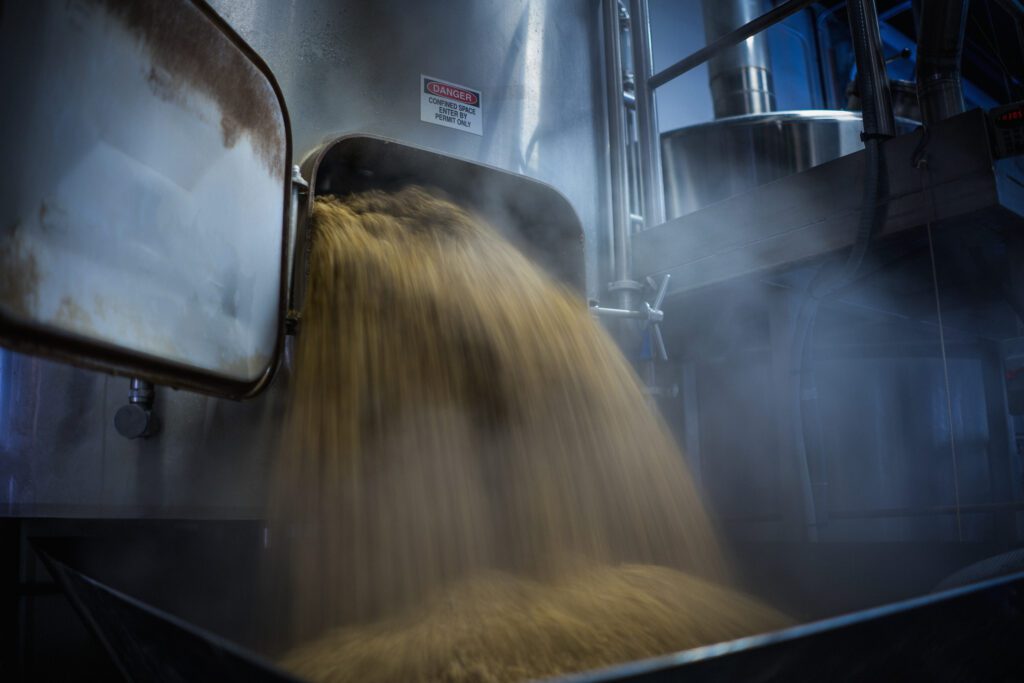The food industry is undergoing a transformation, driven by the need for sustainable and efficient resource use. One promising innovation is the upcycling of brewers spent grain (BSG) into barley malt rice protein—a functional and nutritional ingredient that aligns with circular economy principles. This process not only reduces food waste but also provides manufacturers with an alternative high-quality protein source that enhances product formulations while minimising environmental impact.
Brewers spent grain is an abundant co-product of beer production, rich in protein and fibre. Recent advancements in food processing technology enable the extraction of high-quality protein from BSG, offering a sustainable and cost-effective solution for food and beverage manufacturers.
This article explores the circular economy’s role in transforming BSG into a valuable protein ingredient, detailing the extraction process, nutritional benefits, and functional applications. It also highlights the environmental advantages and market opportunities of incorporating upcycled proteins into food manufacturing. As consumer demand for sustainable and plant-based ingredients rises, barley malt rice protein represents a compelling solution that bridges innovation and sustainability in the food industry.
The Circular Economy
Principles of Circular Economy in the Food Industry
The circular economy model shifts food production away from the traditional linear system of “take, make, dispose” by focusing on resource efficiency and repurposing waste. This approach keeps materials in use for as long as possible, minimising environmental impact. Breweries generate large volumes of brewers spent grain (BSG), a nutrient-rich by-product. Instead of discarding it, processors can convert BSG into functional protein ingredients, such as barley malt rice protein, closing the resource loop.
Reducing Waste Through Innovative Use of By-Products
Food producers use various approaches to extract valuable nutrients from BSG, reducing dependency on virgin raw materials. Processes such as enzymatic hydrolysis and fermentation enable the separation and refinement of proteins, fibres, and bioactive compounds. These extracted proteins can be incorporated into alternative food sources, improving sustainability while maintaining high nutritional value.
Several industries already repurpose food by-products to replace conventional ingredients. Dairy manufacturers utilise whey protein recovered from cheese production, while fruit processors extract pectin from citrus peels. By integrating similar methods in brewing, spent grain transforms into a viable protein source, rather than ending up in landfills or low-value applications like animal feed.
Benefits of a Circular Approach for Both Manufacturers and the Environment
- Economic Gains: Using BSG as a raw material reduces reliance on other protein sources. . Breweries generate additional revenue by selling processed protein instead of treating spent grain as waste.
- Resource Efficiency: Upcycling beer production residue optimises agricultural inputs, reducing the demand for new crops solely for protein extraction.
- Lower Carbon Footprint: Diverting BSG from waste disposal minimises methane emissions from landfills and reduces energy consumption in alternative protein farming.
- Innovation in Sustainable Food Solutions: Functional proteins derived from spent grain offer formulators new options in plant-based foods, supporting the rise of climate-friendly diets.
The circular economy redefines waste as a resource, turning brewers spent grain into barley malt rice protein instead of discarding it. This approach benefits not only food manufacturers but also contributes to sustainable food production and environmental conservation.

Process of Converting BSG into High-Quality Protein
Brewers spent grain contains up to 30% protein on a dry weight basis, making it a valuable raw material for protein extraction. The process starts with separating insoluble fibre from protein and other soluble components. Alkali or acid pretreatment disrupts the lignocellulosic matrix, improving protein solubility. Enzymatic hydrolysis using proteases then breaks down protein complexes into peptides, enhancing extraction efficiency.
Following hydrolysis, protein recovery relies on precipitation techniques such as isoelectric precipitation or ultrafiltration. Adjusting pH to the isoelectric point of barley proteins (approximately pH 4.5) facilitates their precipitation, while ultrafiltration concentrates the protein fraction by removing low molecular weight solutes. The final step involves spray-drying or freeze-drying to obtain a stable protein powder with high functional and nutritional properties.
The Role of Technology in Maximising Yield and Maintaining Protein Quality
Advancements in extraction technology improve both protein yield and quality. High-pressure homogenisation enhances cell disruption, increasing protein release. Membrane filtration processes, including microfiltration and ultrafiltration, enable selective concentration of high purity protein while retaining essential amino acids.
Non-thermal techniques such as ultrasound-assisted extraction reduce processing time and prevent protein degradation. Supercritical fluid extraction, though less common from protein recovery, minimises the need for chemical solvents and preserves bioactive compounds. Combining these technologies optimises recovery rates, resulting in a protein powder with superior digestibility and functional characteristics.
Comparison of BSG Protein with Other Alternative Protein Sources
- Protein Content: BSG-derived protein contains approximately 20-30% protein, comparable to soy protein isolates but lower than traditional whey protein concentrates.
- Amino Acid Composition: Rich in glutamine, proline, and leucine, but lower in lysine compared to soybean and pea protein. However, when Barley Malt Rice Protein, for example, is combined with another plant-based protein, such as Fava Bean Protein, it is possible to create a complete amino acid profile.
- Digestibility: Enzymatic hydrolysis improves digestibility, making it a competitive alternative to plant-based proteins.
- Functional Properties: Exhibits excellent water-holding capacity, emulsification, and foaming properties, making it suitable for bakery, dairy, and meat analogue applications.
Compared to soy and pea proteins, BSG protein offers sustainability advantages due to its upcycled nature. The absence of allergenic concerns associated with dairy and soybean proteins further enhances its appeal for clean-label food innovations.

Barley Malt Rice Protein: Nutritional and Functional Attributes
Nutritional Benefits of Barley Malt Rice Protein
Barley malt rice protein delivers a rich nutritional profile, combining the strengths of both barley and rice-derived proteins. It contains essential amino acids necessary for muscle repair and overall metabolic function. With a balanced macronutrient composition, it serves as a viable protein source for various dietary needs.
Compared to traditional animal-based proteins, barley malt rice protein has a lower saturated fat content while still providing ample protein density. This makes it a favourable option for individuals seeking plant-based nutrition without compromising protein intake. The fibre content from barley-based components further enhances digestive health and aids in gut microbiota balance.
A Plant based Alternative
Plant-based diets continue to gain traction, necessitating alternative protein sources that align with vegan and vegetarian lifestyles. Due to is unique solubility barley malt rice protein isolate integrates seamlessly into plant-based formulations, offering not only protein diversity but also improved textural properties in food applications.
Amino Acid Profile and Bioavailability Analysis
A complete amino acid profile ensures a protein source can support essential physiological functions. Barley malt rice protein contains significant levels of leucine, isoleucine, and valine, which contribute to muscle protein synthesis. These branched-chain amino acids (BCAAs) are particularly beneficial for sports nutrition and active lifestyles.
- Leucine – Triggers muscle protein synthesis and aids muscle recovery.
- Lysine – Supports collagen formation and immune system function.
- Methionine – Plays a vital role in methylation processes and antioxidant defence.
- Arginine – Enhances oxide production, improving blood circulation.
While rice protein alone exhibits lysine content, integration with barley-derived proteins addresses this deficiency, improving the overall score of essential amino acids. The bioavailability of this protein blend depends on extraction methodologies and processing techniques, with enzymatic hydrolysis enhances digestibility up to 90%, enabling efficient abruption by the body.
Innovations in Brewery Waste Management
While several breweries have developed waste management solutions that transform BSG into valuable products, evergrain, an Anheuser-Busch InBev is one of the few breweries to commercialize and scale this initiative. Evergrain has commercialized a everpro – a barley rice protein isolate,.. By implementing proprietary, advanced extraction techniques, evergrain has introduced high-protein, barley-based ingredients – everpro suitable for food and beverage applications.
Applications in Food Manufacturing
Barley malt rice protein functions as a high-quality, highly soluble protein source with distinct functional properties. Food manufacturers integrate it into diverse applications, enhancing both the nutritional content and texture of a product. Its protein-rich composition supports usage in…
- Baked Goods: When incorporated into bread, muffins, and crackers, barley malt rice protein improves protein content whilst maintaining structural integrity. Its water-binding capabilities also enhance moisture retention, leading to softer textures.
- Plant-Based Meat Alternatives: Due to its emulsifying and gelling properties, it helps serve as a stabiliser in meat substitutes, improving mouthfeel and protein balance.
- Protein-Enriched Beverages: Functional drinks, such as proteins shakes and dairy alternatives, benefit from its solubility and neutral flavour, ensuring smooth texture and balanced taste.
- Snack Foods: Protein-enriched snacks, such as energy bars and crisps, utilise barley malt rice protein for its amino acid profile and crisping qualities in extrusion processes.
Manufacturers seeking sustainable solutions integrate this protein into various formulations without compromising sensory attributes. Its compatibility with existing production techniques simplifies adoption in large-scale food processing.

Trends and Consumer Demand Driving the Use of Functional Ingredients
Consumers actively seek protein-enriched foods, driving demand for alternative protein sources with sustainability credentials. Barley malt rice protein aligns with this trend, offering both sustainability and nutrition.
- Clean Label Movement: Shoppers are prioritising natural, minimally processed ingredients.
- Plant-Based Market Growth: The global plant-based food market continues expanding, creating opportunities for plant-based protein sources.
- Functional Nutrition Preferences: Consumers recognise the benefits of protein-enriched diets, supporting demand for fortified grains and snacks.
Major food brands have responded by reformulating products, reducing reliance on traditional proteins like soy and whey. Breweries exploring co-product valorisation meet sustainability expectations while contributing functional ingredients to mainstream food production.
Regulatory Aspects of Incorporating Brewery By-Products in Food Items
Regulatory frameworks support the safe use of brewery by-products in food applications. The European Food Safety Authority (EFSA) and the U.S. Food and Drug Administration (FDA) classify spent grains as Generally Recognised as Safe (GRAS) when properly processed.
Regulatory considerations focus on:
- Food Safety Standards: Proper handling and processing ensure microbial safety and compliance within hygiene regulations.
- Labelling Requirements: Transparency in ingredient listing and allergen declarations remain mandatory for consumer awareness.
- Upcycling Certification: Some markets encourage certifications that highlight sustainable sourcing, improving consumer trust.
Food manufacturers navigating these regulations secure compliance by aligning with industry best practises. Adoption of barley malt rice proteins within regulated parameters ensures both food safety and market acceptance.

Positioning Barley Malt Rice Protein in Competitive Food and Beverage Markets
Barley malt rice protein differentiates itself through unique nutritional benefits and functional properties.
Market strategies can highlight its amino acid profile, solubility, digestibility, and sustainability benefits. Compared to other protein sources, BSG-derived proteins are more soluble, highly digestible and have the added advantage of reducing environmental impact by utilising an existing co-product.
Functional properties also influence adoption in food manufacturing. Barley malt rice protein demonstrates high solubility, with its strong water-binding capacity, making it suitable for bakery applications, meat alternatives, and beverages.
A Powerful Plant Protein Isolate
Repurposing brewers spent grain (BSG) into barley malt rice protein adds value to an abundant co-product of the beer industry. This upcycling process reduces waste, enhances resource efficiency, and contributes to a more sustainable food supply. Extracted protein from BSG offers excellent nutritional and functional attributes, making it a viable protein source.




